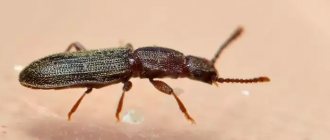There are many ways to fight moles. Some are designed only to catch animals, others are designed to immediately destroy them, and others are designed to ensure that the moles will leave the area on their own due to unfavorable conditions for them. We will tell you about the most effective methods.
A mole is an undeservedly offended creature. All sins are attributed to him that he did not commit. Root vegetables in the garden are gnawed - the mole is to blame! The roots of plants are gnawed - the work of a mole's hands (teeth)! The whole earth is up in arms - the mole has done a mischief again! But in reality, there is more than one mole operating in our gardens - there are several underground pest animals. And often it is they, and not the mole, who ruin our lives.
Who is causing us trouble and causing material damage? To understand this, you need to carefully study the traces of the “crime”. They will tell you who exactly came into our possessions.
What is the difference between a mole, a mole rat and a water vole?
At the summer cottage, three animals are engaged in underground “dirty tricks”: a mole, a mole rat and a water vole.
The water vole is better known as the water rat, or ground rat. Although in fact it is not a rat at all, but an animal of the Hamster family, because of their external similarity, the water vole is in everyday use called a rat. Often in the fall, during the preparation of supplies for the winter, this animal ends up in our gardens. That's when it starts to engage in sabotage. Root vegetables, tubers or plant bulbs that have been gnawed - the vole has worked with its teeth. If you notice that someone has gnawed the bark of seedlings or damaged the roots of trees, look for an earth rat in your possessions. Here and there mounds of earth appeared from underground passages - and here an earth rat could work.
The common mole rat is an animal from the order of rodents. Like the mole, the mole rat leads an underground lifestyle and, like the mole, has undeveloped eyes (hence the name of the animal). This is where the main similarities between the mole rat and the mole end.
The mole rat is a herbivorous animal. He happily eats plant roots, tubers and bulbs. It also loves above-ground parts: stems and leaves. The feeding passages of the mole rat are deeper than those of the mole - at a depth of 20-25 cm, while for the mole it is only 2-5 cm from the surface of the earth.
The mole, unlike the listed animals, does not feed on vegetation, because he is an insectivorous animal. Its main food is earthworms, so it is wrong to blame the gnawed crop on the mole. He is guilty only of spoiling the appearance of the lawn or area, and of touching the roots of plants while making moves. In other cases, you need to look for other culprits.
Gas poisoning of moles
Poisoning moles with gas
One of the modern means of getting rid of underground pests is the use of poison from moles in the country in the form of poisoning them with gas, which is released when fumigating underground passages with an insecticide.
Dakfosal Antikrot is a poisonous agent against moles and insects, sold in a tube with tablets of 3 pcs. Contains aluminum phosphide, which during the process of fumigation or fumigation releases a poisonous gas that penetrates into the burrows of underground pests and destroys them. Used at air temperatures not lower than +10ºС.
The active substance formed during spraying, phosphine gas, is a fumigant insecticide, which enters the respiratory system of pests and blocks the access of oxygen there, which quickly and effectively leads to their death. The higher the air temperature, the higher the toxicity of the substance.
You can also place the tablets themselves directly in the underground passages of the moles, and then cover them with improvised material (boards or stones) and cover them with soil on top. The consumption of the product is 3 tablets for each hole.
Important!
The fumigation process is best carried out by specialists in a group of several people. When working with such toxic gaseous substances, it is imperative to wear a respirator, protective suit and gloves. The contents of the glass flask must be used in one go, because when air gets into it, an irreversible chemical reaction occurs.
This product is highly toxic to the environment, so it is not recommended for use in the garden due to its negative effect on the soil and plants.
Plastic bottles from Andrey Berezin
Andrey Berezin used the most famous method of fighting moles - a homemade “noise maker”. To make it, take any plastic bottle and cut 3-5 “windows” on its side surface. Bend the cut plastic to one side. Now all that remains is to attach the noise repeller.
To do this, take a metal rod, and in the bottom of the bottle make a hole with a slightly larger diameter than the diameter of the rod (due to this size, the bottle will not be statically fixed, but will be able to “dangle” freely on the pole, which will create additional sounds). Fix the container on the rod and stick it next to the moles’ habitat. To be safe, make several of these pinwheels and place them every 10-15 m throughout the area.
The wind will create noise, the metal pin will transmit it to the ground. Moles don’t like such a noisy life, so they go to quieter neighbors. As soon as you notice the appearance of new individuals, repeat the procedure.
You can also use this version of the “noise maker”, as in the photo. In this case, the noise is created by rotating blades that are loosely attached to the neck of the bottle.
Gardening tips
Experienced gardeners who have dealt with moles more than once give some advice that can help beginners:
- Before starting any mole extermination activities, it is recommended to try simply filling the underground burrows with water from hoses. to pour until the liquid begins to flow out. Often, pests manage to escape by digging new tunnels, but there is a possibility that the entire family of underground inhabitants will simply drown.
- If measures to flood the holes do not help, then it will be necessary to first determine who is harming the area - moles or rodents, since the methods of dealing with them are fundamentally different.
- The site may contain both used and abandoned underground passages. In order to determine their current condition, it is necessary to crush the earth above them, and after a day check the place for changes. If the ground is raised again, the mole actively moves along it, regarding these tunnels as being in use.
Using used cat litter to fight moles from Evgeniy Klyuev
In war, all means are good. Evgeniy Klyuev, for example, uses used cat litter (a good owner, as you know, never wastes anything, even used cat litter).
In a bucket of water, mix a lump of litter with cat waste. Fill the mole holes with the resulting solution, and then cover them with earth. Take a piece of reinforcement and use it to make many holes in the ground near the molehills. The animals will then move to a safe distance and stay away from your area.
Catching and destroying pests
The method of getting rid of a mole in the garden by catching it is considered one of the most effective and fastest - with the correct placement of the trap, the mole can be caught literally within one or two days. However, if the animal has not been caught in 2-3 days, then the trap is simply moved to another place. Typically, no more than 2-3 rearrangements are required to catch the pest.
On a note
Sometimes experienced gardeners catch moles without using traps or traps at all, but with just a shovel. But, of course, this method is more labor-intensive and requires a lot of time. Such a catch is carried out as follows: the mole must be waylaid, waiting for the moment when it passes through one of the passages closest to the surface of the earth (the soil will rise in this case), then very quickly dig up behind it and throw the earth with the animal to the surface.
In general, catching a mole on a site always requires some effort, much greater than when using repellers. Even if the trap is not made with your own hands, but purchased, to install it you need to find and excavate a passage, install the device correctly and take measures so that the mole does not notice the consequences of the excavation work.
While the effectiveness of various designs of mole traps is comparable, their prices vary greatly. The simplest wire traps cost about 20 rubles apiece, and the most expensive traps cost more than 3,000 rubles.
In addition, it is quite possible to make an effective mole trap with your own hands (more on this below).
Review
“As soon as I saw these piles in my garden, I immediately realized that I needed to act quickly. The garden has already been dug up, the seedlings need to be taken out in a couple of weeks, and here is this comrade. I started to figure out what to do and realized that this is a whole science. This means you need to buy a trap, bury it, if you didn’t bury it there, then dig it up later, and it’s not a fact that it will work. I found guys on the Internet who get rid of moles. I called, the guys arrived with their equipment, set the traps themselves, and left. It took about an hour. The next day one of the guys came and took out a trap with a mole. All. No problem. The price of the issue is 2000 rubles, it’s in Gatchina...”
Pavel, Gatchina
Live traps for moles
The main advantage of live traps is the ability to catch a mole without killing or maiming it, and after catching it, simply take it out of the garden and release it. This is fully consistent with the principles of civilized farming and humane treatment of animals.
Live traps can have different designs, but most often only two options are used:
- A pipe trap that is inserted into the mole's passage, as if continuing it, while its doors easily open inward, but do not open outward. Accordingly, the mole easily crawls into such a mole trap and can no longer get out of it;
- A pit trap, which is a jar, pan or bucket buried under the mole's path. The animal simply falls into the container, running through its tunnel.
The photo below shows an example of an industrially produced mole trap-pipe:
Prices for such traps range from 350-1200 rubles. However, you can make a pipe trap with your own hands:
And the photo below shows a pit trap made from a three-liter jar buried under the mole’s path:
The disadvantages of using live traps are related to the complexity of their installation and the need for regular inspection.
The mole's passage must first be excavated, and then a trap must be installed in it, and this should be done as carefully as possible. Then the “excavation” site must be covered with light-proof fabric or other material and the catch must be checked approximately every 5-6 hours.
On a note
You may ask, why check the trap so often? The fact is that without food, the mole will die of starvation in it within the first 18-24 hours - thus, a humane live trap would turn into a kind of torture chamber for the animal.
After catching the mole, they take it to a distance of 1-1.5 km from the garden plot, and in this case the pest will definitely not come back.
It is also useful to read: Pros and cons of mole trap Cat Fedr
Thus, it is quite obvious that getting rid of moles using live traps, while trying to keep the animals alive, is a very troublesome process. However, the effectiveness of the method is very high and, moreover, the conscience of the owner of the site remains clear.
Review
“Last fall we decided to get rid of moles next season at all costs. The first mole appeared in the yard, and then heaps began to appear throughout the garden. I don’t know how many moles there were in general, but this time we bought two traps in the form of pipes, placed them in the passages, and my husband checked them regularly. The very next day we caught two moles, and then two more within a week. I don’t know why we have so many of them, maybe it was a mother and cubs. My husband took them out to the landing and released them there. And only after that we breathed calmly. Otherwise, all last year we had to clean up this pile; half of the beds were ruined.”
Anna, from correspondence on the forum
Traps and other lethal means
The effectiveness of traps that kill or maim moles is almost the same as that of live traps. The disadvantage lies precisely in the lethality of their action: generally speaking, killing animals just because their home intersects with your property is not very humane.
The undoubted advantage of traps, which many gardeners like, is that their use is much less labor intensive compared to live traps: after installation, the device does not need to be checked too often, and after triggering, the killed animal does not need to be taken out anywhere.
To combat moles in a garden plot, the following types of traps are usually used:
- Wire mole traps that strangle the animal, squeezing its body;
- Scissor traps (plunger traps), when triggered, compress the mole with its staples and break the animal’s bones;
- Harpoon traps piercing the animal with sharp knitting needles;
- Presses in which moles are caught in the same way as mice and rats (in other words, mousetraps).
On a note
Gardeners with increased knacker tendencies prefer to catch moles with fishing hooks tied to a strong fishing line. When moving along an underground passage, the animal is caught by a hook, and a fishing line tied to a long stick does not allow the animal to go further. As a result, the owner of the site, satisfied with the catch, pulls out the struggling mole by the fishing line, often tearing its skin and muscles. However, all these are “little things”, because in a moment the mole will be killed by a log.
Sometimes they try to get rid of moles using electricity, for example, using electric rat traps. This is not without certain problems, since such rat traps require a connection to the network, and garden moles are usually located at a fairly large distance from the nearest outlet.
Perhaps it is also worth noting that when there is neither time nor desire to get rid of moles on your own in a garden plot (especially a large area), then today it is also possible to call special deratization services, which, without any effort on the part of the owner of the plot, will remove all the moles from the plot. vegetable garden
Ruthless fight against underground pests from Alexander Lisichkin
krot911.ru
Our reader Alexander Lisichkin decided to throw all his resources into the fight against moles. First, he suggests using noise repellers made from plastic bottles on poles. And for greater efficiency, at the same time, put dog excrement in the holes. If these methods are unsuccessful, you will have to move on to using traps.
There are two types of traps:
- Traps that kill animals.
- Live traps - in this case the mole will live. However, it is necessary to free the animal from the trap in time, because moles can survive without food for only 14 hours.
Alexander Lisichkin suggests building a live trap. To do this, take a plastic sewer pipe with a diameter of 50 mm. To make a trap, cut about half a meter of such pipe.
Now the entrances at both ends of the pipe need to be closed with “doors”. They can be made from the bottom and top of any tin can that is suitable in size. The height of the “door” should be approximately 5-6 mm larger than the hole, and the width, on the contrary, should be smaller.
Drill holes at the top, above the entrances, and secure the “doors” there with wire. Install them inside the pipe at a slight angle. Thanks to this trick, the mole will easily get inside the trap, but will not be able to get out of there: the “door” is larger than the hole, and the animal will not have enough strength to “open” it to the outside.
Dig up the mole passage and set a trap in the tunnel. The mole, walking through his labyrinths, should not suspect anything. Then he will calmly enter the pipe, but he will not be able to get out.
Help from professionals
If you cannot cope with annoying underground neighbors on your own, then you can turn to qualified specialists for help who know a lot about exterminating moles in household plots (Figure 6).
Specialists in the destruction of underground mammals most often use the following methods in their work:
- Installation of high-quality traps on the territory of the personal plot.
- Fumigation: when using this technique, poisons are used, which will cover the area of the site in the form of steam. This method is one of the most effective and is guaranteed to destroy moles.
- Gasification: This method is based on chemical treatment of mines and tunnels. Depending on the type of insecticide, you can achieve the destruction of harmful animals or drive them into installed traps, or scare them away from your garden plot.
Figure 6. You should resort to the help of professionals in case of mass resettlement of animals.
Using professional help in getting rid of moles, you should be prepared to incur financial expenses to pay for the services of professionals, but in return you will get the desired result and get rid of the “blind ones”.
Ruthless mole hunting from Nikolai
Nikolai suggests immediately starting to fight moles tooth and nail. And he suggests starting with traps. Dig up several mole holes and set traps in them. After that, cover everything again with soil.
If you find a passage that goes at an angle deep into the earth, Nikolai suggests filling it. Pour in kerosene. Thanks to its very strong and unpleasant smell, it will force moles to leave their homes and go “for permanent residence” to another area.
In addition to the above, many of our readers who have freed their territories from moles recommend getting a rat-catcher cat or hunting dogs: dachshund, spaniel, terrier, etc. These animals will forever relieve you of the worries of fighting moles and other pests.
Have you ever had to fight moles on your property? And who won?
Prevention
Given the characteristics of moles, it is much more difficult to get rid of them than from rodents or other pests, so it is recommended to follow preventive measures that can help prevent the likelihood of their appearance on the site:
- Installation of a fairly rigid and solid fence along the boundaries of the entire site; the material can be used linoleum , roofing felt, slate or ordinary metal mesh, which will need to be folded in several layers. The fence is buried in the ground, the height above the ground surface should be at least 50 cm, then the result will be a barrier that underground inhabitants will not be able to overcome.
- Planting onion plants and legumes on the site.
- Organization of ditches along the perimeter of the site, which are filled with gravel, crushed stone and coarse sand; these layers can be covered with ordinary soil on top. However, it is worth noting that if a mole is attracted to something on the site, then such a barrier will only delay it, but will not be able to stop it.
How to avoid moles
It has been noticed that moles avoid areas where dogs live. Perhaps they are afraid of a potential hunter and prefer not to take risks.
An expensive but reliable way to prevent moles from settling in your garden is as follows. It is necessary to select a fine galvanized mesh of such length that it is enough to fence the area around the perimeter. The width of the mesh should be at least 70 cm:
- 50 cm, dug into the ground;
- 20 cm protruding above the surface.
The mesh will protect the area from penetration by moles: mammals simply will not be able to crawl through it. The net will not be an obstacle for worms and insects.
The second option is to dig slate sheets into the ground. The disadvantage of this method is that the garden is completely isolated from worms, which benefit the plants.
Moles are smart animals that simply weren’t lucky enough to look for food in a person’s garden. The “pests” even bring some benefits: they improve soil ventilation and eat the larvae of May beetles. Therefore, you should not put moles to a cruel death. Why not do a good deed by releasing an animal into the wild somewhere closer to nature?
kak-izbavitsya-ot.com
Folk method with shovels against moles in the garden
- Move slowly along the furrow of the mole tunnel: move in small steps, carefully pressing down the earth and grass, leveling the soil. Despite the fact that moles are blind, they have very good hearing and sense of smell, so excessive noise and movement can scare them away - the animals will go deeper and it will be more difficult to catch them.
- You should position yourself with shovels and a hammer closer to where the moles are working. Periodically inspect the area for active “excavations.” Moles usually feed in the morning, noon and evening.
- If you notice that old furrows are being dug further, or new ones are forming, then there is a mole at the end of the tunnel. Quietly creep up to the edge and stick a shovel behind the mole's expected work area to prevent it from escaping. Stick another shovel directly in front of the mole at the end of the hole. The mole will either hit the shovel and die, or he can be hit with a hammer.
- This procedure will have to be repeated many times, since moles usually have large families.
This is also interesting: What do moles eat? What do they need from your garden?
A few words about mole traps
Another radical way to get rid of underground animals is special mole traps. These items are made from wire and are sold at most hardware stores. You can also see traps made of plastic there, but such devices can only hold a very weak or young animal.
When using mole traps, correct placement is also very important. Before installing traps, you should walk through the area and crush the piles there. If the molehills are restored within a short time, you can try placing mole traps. Place them two at a time so that the input rings are directed in different directions. It is worth considering that if the site is close to a field, meadow or forest, then new animals will soon appear in the garden.
Did you like our article?
We invite you to join our friendly community on VKontakte, Facebook and Odnoklassniki. Share something interesting!
Share this article with your friends and acquaintances on your favorite social network using the buttons in the panel on the right. Leave your comments and reviews, we will be glad to hear your opinion.
miaflora.ru
Scare away with smells
It is more difficult to repel moles with odors than insects. If an odorous substance gets into the tunnel, the burrowing animal will make a new move, but will not leave the area. Scented repellents can only work at the stage of development of the site if they are buried along its perimeter or along the fence separating the dacha from the neighboring meadow. Moles come to the garden from the wild because they find more food in the treated and moistened soil.
At a depth of 50-80 cm, you can bury rags soaked in gasoline, waste oil, kerosene, diesel fuel and other petroleum products, which will create a barrier for soil pests seeking to enter the garden. This way you can scare away not only the mole, but also the mole cricket. The smells will last for several years.
What may shrews be afraid of?
Since moles have practically no developed vision, they receive all information through hearing and smell. However, they cannot tolerate strong odors and sounds, for example, the “aroma” of rotting fish, the smell of valerian, white spirit and other chemicals. Shrews also don’t particularly dislike vibration and loud noises.
If you liked the article, please share it
Previously on the topic:
Share
What damage do moles cause?
Moles prefer to hunt in the loose soil of vegetable gardens and garden plots, as there are a large number of earthworms there. In the process, they often damage the root system of various plants: flowers, vegetables, berries, as well as young trees and shrubs.
The soil thrown outside not only spoils the appearance of the lawn, but also interferes with the use of the lawn mower. Moles become a real disaster for landscape design, because the animals can adjust flower beds or garden paths in their own way. In addition, heaps of earth block the flow of water in the drainage system of the site, which means that cleaning work will have to be carried out regularly.
Interestingly, a few decades ago, moles were exterminated for the purpose of harvesting fur. Their soft skin was highly valued. However, to date, there is no fishing for moles, and in European countries the destruction of animals is completely prohibited, and they are also listed in the Red Book. Therefore, measures to combat animals in the European Union boil down to driving away animals, but at the same time saving their lives.
Specialized repellers
Manufacturers of goods for gardeners produce special repellent devices. The principle of their operation is to emit ultrasound or sound waves. Many run on solar panels and do not require a connection to the grid.
You can buy a repeller (Antikrot, Ecotec, Help, etc.) in online stores or retail outlets for gardeners. They are distinguished by ease of installation (you need to stick the device's pin into the soil) and low maintenance. But this method has a drawback: animals quickly get used to the effects of sound and stop perceiving it as a sign of danger.











